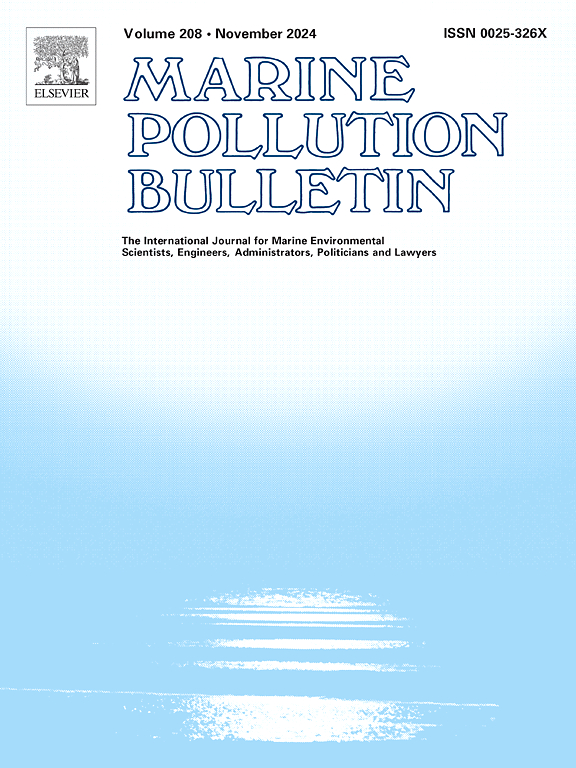加拿大圣劳伦斯河和河口底栖鱼类中的微塑料:发生、空间分布和生态风险评估
IF 5.3
3区 环境科学与生态学
Q1 ENVIRONMENTAL SCIENCES
引用次数: 0
摘要
加拿大圣劳伦斯河和河口(SLRE)的微塑料污染对水生物种构成潜在风险。然而,对底栖鱼类的微塑料污染的了解有限,可能比远洋物种更脆弱,阻碍了这一重要生态系统的有效风险评估。本研究通过分析海峡鲶鱼(Ictalurus punctatus)和大西洋Tomcod (Microgadus Tomcod)胃肠道(GIT)和鳃中的微塑料来弥补知识空白。采用KOH消解、密度分离、湿式过氧化和光谱学对来自10个站点的42条鱼进行了检测。结果表明,每条鱼的平均丰度为3.0±0.4(平均±SE)。大多数检测到的颗粒为小微塑料(809 μm)和纤维,呈蓝色和透明色。鉴定出的主要聚合物包括聚对苯二甲酸乙二醇酯和聚乙烯。虽然鲶鱼的个体微塑料丰度高于小鳕,但基于GIT重量的数据并不支持这种捕食者-猎物关系中的微塑料生物放大。与上游50公里处发现的平均丰度相比,曲青贝克市下游的鲶鱼显示出较高的微塑料水平,其特征变化更大。城市活动可能会增加下游底栖鱼类和其他鱼类的微塑料积累。这突出表明需要进一步研究鱼类的洄游能力。生态风险评估显示,由于较小的微塑料<;809 μm和高毒性聚合物(聚甲基丙烯酸甲酯、聚氯乙烯、聚氨酯、丙烯腈-丁二烯-苯乙烯)的普遍存在,靠近quacimbec市的鲶鱼站存在中至高风险。本研究为海洋鱼类塑料污染监测和生态风险评估提供了基础。本文章由计算机程序翻译,如有差异,请以英文原文为准。
Microplastics in the benthic fish from the Canadian St. Lawrence River and Estuary: Occurrence, spatial distribution and ecological risk assessment
Microplastic contamination in the St. Lawrence River and Estuary (SLRE), Canada, poses potential risks to aquatic species. However, limited understanding of microplastic contamination in benthic fish, potentially more vulnerable than pelagic species, impedes effective risk assessment in this crucial ecosystem. This study addressed knowledge gaps by analyzing microplastics in the gastrointestinal tracts (GIT) and gills of Channel Catfish (Ictalurus punctatus) and Atlantic Tomcod (Microgadus tomcod) in the SLRE. Forty-two fish from ten stations were examined using KOH digestion, density separation, wet-peroxidation, and spectroscopy. Results indicated an average abundance of 3.0 ± 0.4 (mean ± SE) microplastic particles per individual fish. Most detected particles were small microplastics (<809 μm) and fibers, with blue and transparent colors. Major polymers identified included polyethylene terephthalate and polyethylene. While catfish showed higher microplastic abundances per individual than tomcod, data based on GIT weight do not support microplastic biomagnification in this predator-prey relationship. Catfish from downstream of Québec City showed elevated levels of microplastics and more variations in their characteristics compared to average abundance found from a site located 50 km upstream. Urban activity may increase microplastic accumulation in downstream benthic fish and others. This highlights the need for further studies on the migratory capacities of fish species. Ecological risk assessment revealed medium to high-risks for the catfish stations close to the Québec City due to the prevalence of smaller microplastics <809 μm and highly toxic polymers (polymethyl methacrylate, polyvinylchloride, polyurethane, acrylonitrile butadiene styrene). This study provides a baseline for monitoring plastic pollution in the SLRE fish and assessing ecological risks.
求助全文
通过发布文献求助,成功后即可免费获取论文全文。
去求助
来源期刊

Marine pollution bulletin
环境科学-海洋与淡水生物学
CiteScore
10.20
自引率
15.50%
发文量
1077
审稿时长
68 days
期刊介绍:
Marine Pollution Bulletin is concerned with the rational use of maritime and marine resources in estuaries, the seas and oceans, as well as with documenting marine pollution and introducing new forms of measurement and analysis. A wide range of topics are discussed as news, comment, reviews and research reports, not only on effluent disposal and pollution control, but also on the management, economic aspects and protection of the marine environment in general.
 求助内容:
求助内容: 应助结果提醒方式:
应助结果提醒方式:


